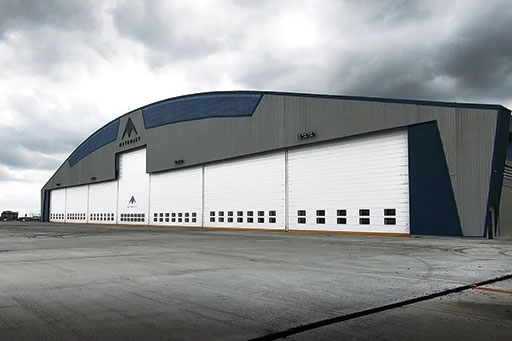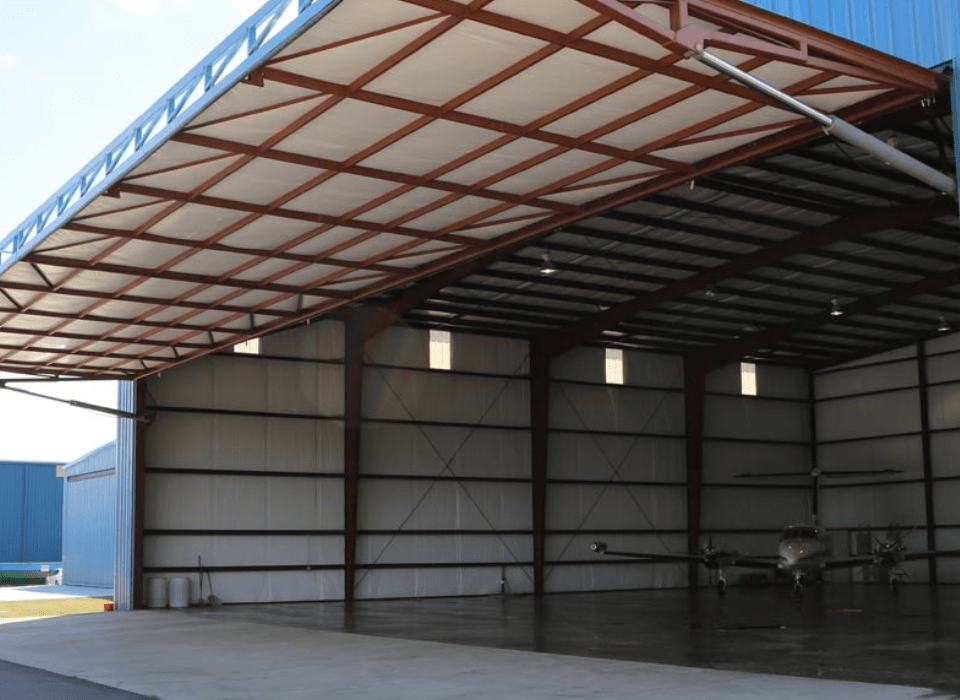When it comes to equipping your hangar, choosing the right type of door is one of the most critical decisions you’ll make. Hangar doors aren’t just a functional necessity—they impact the efficiency, safety, and overall value of your facility. The two most common options are hydraulic and traditional (also known as sliding or bifold) hangar doors. Each has its pros and cons, and the best choice depends on your specific needs, budget, and the intended use of your hangar. Let’s break down the key differences between hydraulic and traditional hangar doors to help you make an informed decision.
Hydraulic Hangar Doors
Hydraulic hangar doors have gained popularity for their sleek design and easy operation. These doors are powered by hydraulic systems that lift the door vertically, allowing for seamless opening and closing. They are often one solid panel that swings outward, providing a simple, clean look.
Advantages of Hydraulic Hangar Doors:
- Ease of Operation: Hydraulic doors are incredibly easy to operate with the press of a button. Their design allows for a smooth, single motion that makes opening and closing fast and simple.
- Weather Tight Seal: Hydraulic doors typically provide a better seal against the elements, which is ideal for hangars in areas with extreme weather conditions. The tight seal helps maintain interior temperatures and protects aircraft from water, wind, and dust.
- Maximized Opening Height: Since hydraulic doors open outward as one solid piece, they don’t require a top clearance track, maximizing the available vertical space. This makes them an excellent choice for larger aircraft that need full vertical clearance when entering or exiting the hangar.
- Durability: These doors are designed to last, with fewer moving parts compared to traditional hangar doors, meaning there are fewer components that could wear out or require maintenance. The heavy-duty materials used in hydraulic doors are built to withstand harsh environments and high winds.
- Customization Options: Hydraulic doors can be custom-built to suit a wide range of hangar sizes and design preferences. Many manufacturers offer various cladding options and windows, allowing you to match the aesthetics of your facility.
Disadvantages of Hydraulic Hangar Doors:
- Cost: Hydraulic doors can be more expensive upfront due to their complex systems and heavy-duty components. Installation costs may also be higher because of the need for hydraulic equipment and skilled labor.
- Space Requirement: Since hydraulic doors swing outward, you need to ensure that there is enough clearance in front of the hangar to accommodate the door when it is fully open. This may not be suitable for hangars located in tight spaces or busy airfields.
Traditional Hangar Doors
Traditional hangar doors—whether sliding, bifold, or multi-panel—are widely used in both small private hangars and large commercial facilities. These doors slide horizontally or fold vertically, depending on the specific design.
Advantages of Traditional Hangar Doors:
- Affordability: One of the biggest advantages of traditional hangar doors is their lower cost. In general, sliding and bifold doors are more affordable to install and maintain, making them a great option for budget-conscious hangar owners.
- Minimal Front Clearance: Traditional sliding doors don’t require extra space in front of the hangar because they move horizontally or vertically within the hangar’s footprint. This is beneficial if your hangar is situated in a tight location where outward-swinging doors would be impractical.
- Simplicity: Sliding and bifold doors are straightforward in design, with fewer complex parts compared to hydraulic systems. This simplicity can translate to lower long-term maintenance costs.
- Energy Efficiency: In some designs, traditional bifold doors can be equipped with insulation, which helps improve the energy efficiency of the hangar, keeping aircraft in better condition during cold winters or hot summers.
Disadvantages of Traditional Hangar Doors:
- Manual Operation (in some models): Depending on the type of traditional hangar door, you may need to manually slide or fold the panels, which can be cumbersome for larger doors. While there are motorized options available, manual operation can slow down workflows.
- Requires Maintenance: Sliding and bifold doors often come with more moving parts, such as tracks, pulleys, and hinges, which can wear out over time and require regular maintenance to keep them functioning smoothly.
- Limited Vertical Clearance: Some traditional doors, particularly bifold designs, may reduce the available vertical clearance because the door panels fold upward. This could be an issue if you frequently store taller aircraft or need every inch of your hangar’s height.
- Less Weather Resistance: Traditional hangar doors may not offer the same level of weather tightness as hydraulic doors. Over time, wear and tear on tracks and seals could lead to drafts, leaks, or even structural damage in extreme weather conditions.
Which Door is Right for Your Hangar?
Choosing between hydraulic and traditional hangar doors comes down to weighing your priorities: cost, functionality, space, and the specific needs of your aircraft. Here are a few questions to consider:
- What is your budget? If cost is your top priority, traditional sliding or bifold doors might be the best option. However, if long-term durability and ease of use are important, the extra investment in a hydraulic door could pay off.
- How much space is available outside your hangar? If you have plenty of space outside your hangar for an outward-swinging door, a hydraulic option can provide a cleaner, more modern look. However, if space is limited, a traditional door may be more practical.
- Do you need full vertical clearance? If you’re storing large aircraft and need maximum clearance, hydraulic doors are the superior choice because they don’t require overhead tracks that could limit the height of your opening.
- What are the weather conditions in your area? If your hangar is located in an area with extreme weather, the better seal of a hydraulic door can help protect your aircraft and minimize energy costs. Traditional doors may require more upkeep to maintain their weather resistance.
Both hydraulic and traditional hangar doors have their benefits, and the right choice depends on your hangar’s unique requirements. Hydraulic doors offer superior ease of use, durability, and a weather-tight seal, but at a higher cost. Traditional doors are more affordable and perform well in tight spaces, though they may require more maintenance and offer less vertical clearance. Before making your decision, assess your hangar’s size, location, and budget to find the door that will keep your aircraft safe and secure.
Not sure which option is best for you? At Well Bilt Doors, we specialize in providing custom solutions tailored to your specific needs. Whether you’re leaning toward hydraulic or traditional, our expert team can guide you through the process and help you choose the perfect door for your hangar. Contact us today to get started on securing your aircraft with a door built to last!


